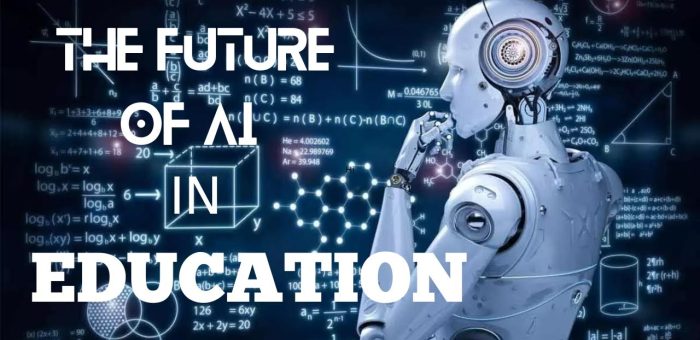
The Present and Future of AI in Education
Think of a time when you are walking into a classroom where lessons adapt to how you learn. The computer knows when you’re confused. It slows down, explains the concept again, and even provides small games to help you understand better. That’s no longer science fiction, but that’s what AI is doing in education today.
All these smart tutors and essay checkers are highly influenced by artificial intelligence. This technology has changed how students learn and teachers teach. It has made study time shorter and learning easier. Students who once struggled with math or writing now get real-time help right from their laptops.
But this is just the start. The future of AI in education is going to be even more personal, faster, and fairer. It’s opening doors for every kind of learner, from small towns to big cities.
In this blog, we’ll take a closer look at how AI is already changing the classroom, what the future may bring, and how both students and teachers can make the most of it. It’s all about seeing how learning grows and what it means for each of us.
How AI Is Changing the Classroom Today
Schools today don’t feel like they used to. Things move faster. Lessons are more flexible. A big reason for that is AI. It has quietly made its way into classrooms, changing how students learn and how teachers work.
Teachers now get help with small tasks that used to take hours. Students get quick feedback without waiting. It’s not replacing anyone, but it’s just making things a bit smoother for everyone.
| Area of Learning | What AI Does | Example |
| Homework Help | Checks mistakes and gives quick replies | Simple chat tools that fix grammar or help with math
|
| Class Lessons | Suggests what to study next | Tools that match lessons to how each student learns
|
| Teacher Support | Reduces marking time | AI that grades short tests or tracks class progress
|
| Study Tips | Sends reminders or small quizzes | Study apps that help plan what to revise
|
Some teachers also suggest their students reliable platforms like Assignment Master for support. It guides students who need a little extra help. It’s proof that when humans and tech work together, learning feels lighter and more personal.
- Use of AI Tools in Schools (2024)
| Group | % Using AI |
| Students | 70% |
| Teachers | 35% |
| Schools with AI programs | 55% |
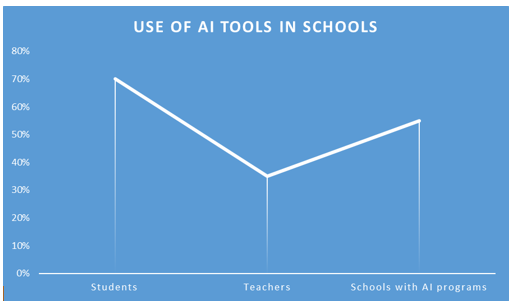
It’s clear that AI is slowly becoming part of daily school life. Many students already use it for study help or quick answers. Some teachers are also opting to save time when it comes to planning and grading.
However, AI is not here to replace anyone’s job. It’s more like an extra hand. Teachers still do the real work, like talking, explaining, and helping students understand. AI helps with all the small tasks that consume their time.
For students, it is like having a study partner who is always ready to help. They can learn at their own pace that feels right for them.
The Good Side of AI in Education
There’s no denying it. AI has made school life a bit easier. Teachers often discuss how it eases the workload, and students say it helps them when they are unclear about something. It is not magic but a small support that brings all the big differences.
For teachers, it’s like a few hours invested in checking papers and planning lessons. That time can now go into talking to students, explaining things, or giving feedback that actually helps.
For students, it feels like having quiet help in the background. They can ask questions at any time, repeat lessons if needed, or learn something new simply because they’re curious.
It’s not replacing real teachers. It’s just filling the small gaps and the moments when a student needs a little push or a teacher needs a break. That’s where AI fits in best.
The Struggling Phase of AI
Undoubtedly, AI is smart, but it still has a lot to learn. Sometimes, it provides incorrect answers. Sometimes it doesn’t understand what students really mean. And sometimes, it just feels… cold.
Teachers say that’s the hardest part, and the lack of heart. AI can’t notice when a student looks confused or tired. It can’t smile or say, “Don’t worry, you’ll get it next time.”
There’s also the problem of too much trust. Some students let AI do all the work. They copy, paste, and move on without learning much. That’s not the goal.
Schools are now looking for ways to bring the right balance to things. It is beneficial to utilise AI, but it is essential not to rely too heavily on it. Learn new things from it, but don’t depend on it. Learn from it and don’t lose your own creativity.
- Common AI Issues in Classrooms
| Problem | % of Schools Reporting It |
| Wrong answers or facts | 48% |
| Overuse by students | 60% |
| Lack of emotional touch | 72% |
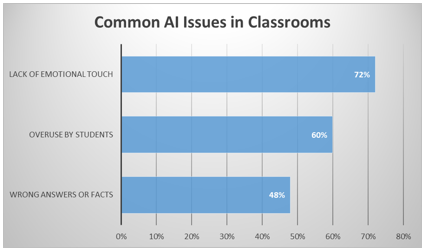
AI can be helpful, but it still requires human guidance, like teachers to give it purpose and students to use it wisely.
The Future of AI in Education
No one really knows what classrooms will look like in a few years, but one thing is clear: AI will be part of it. Not to take over, but to help people do things better.
Soon, lessons might feel more personal. Each student could have a digital helper that knows how they learn best. Some may like videos. Some may prefer small quizzes. Others may just need a bit more time. AI can quietly adjust to that.
Teachers might get tools that make planning lessons as easy as typing an idea. They’ll spend less time on screens and more time with students. That’s what everyone wants, a more real talk, less routine.
But the heart of learning will stay the same. It will still be about curiosity, kindness, and effort.
- What Teachers Expect from AI 2025 Forecast
| Expectation | % of Teachers Agreeing |
| More personalized learning | 68% |
| Easier lesson planning | 57% |
| Better student tracking | 46% |
| Emotional support for students | 12% |
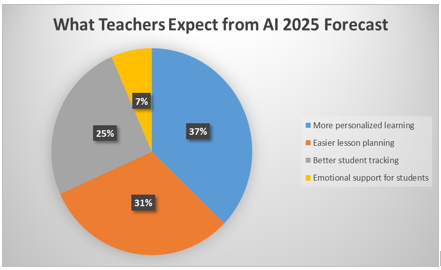
The future won’t be about choosing between people and AI. It’ll be about both working together, making learning smoother and kinder at the same time.
Finding the Balance
AI can help with many things, but there’s something important to remember: balance. When students start depending too much on machines, they miss the real part of learning that is thinking, asking, and understanding.
That’s why schools and parents now talk a lot about using technology wisely. AI should be a tool, not a shortcut. Students can use it to save time, just like how they might use a university assignment writing service to get help when things get tough, but not to skip the effort.
The real goal is to learn smarter, not lazier. With the right balance, AI can become a support system that helps students grow in both skill and confidence.
Real Learning Still Needs Real People
Despite how advanced AI has become, it can’t replace genuine mistakes, moments, and conversations between students and teachers. Learning not only depends on getting the right answers, but it also depends on asking better questions.
Teachers pay attention to when someone’s having a tough day. They can tell when a student feels proud or upset. AI doesn’t feel that. It can explain a topic, but it can’t understand emotion. That’s something only people can do.
Students still need that push, the kind that comes from a teacher saying, “You can do this.” AI can’t give that feeling.
So yes, AI helps. It makes things easier. However, the real change still begins with people, particularly those who teach, listen, and care.
- What Students Still Value Most
| What Matters | % of Students Agreeing |
| Kind teachers and mentors | 82% |
| Face-to-face learning | 74%
|
| AI or online support | 39% |
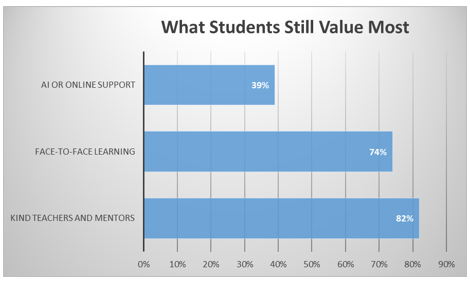
Technology can teach facts. But people teach values. That’s what keeps learning real.
Frequently Asked Questions
1 – Will teachers get replaced by AI?
No. It can’t listen or care like people do. A teacher can tell when someone is lost or upset. AI can’t do that. This is a big difference.
2 – Can students ask AI for help when doing their homework?
Yes, they can, but shouldn’t fully depend on it. It’s okay to use it for ideas or corrections. But the real learning happens when you think for yourself.
3 – How can schools ensure the fair use of AI?
By setting clear rules. Some teachers already show students how to use it without crossing lines. It’s about learning smart, not taking shortcuts.
4 – Does AI make education more costly?
Not really. A lot of tools are free. Some are even built into what schools already use. The important part is to use them wisely.
The Ending Notes
AI is changing the way students learn and teachers work. This technology is going to stay and last longer. However, the core of education remains unchanged. It’s still about people. It’s about questions, effort, and kindness, the things no machine can ever replace.
If used properly, AI can make learning much easier. It can bring new ideas, save time, and provide support when required. However, it should never replace real teaching.
Teachers still shape minds. Students still dream big. AI is just the tool that helps both sides reach a little higher.
The future of education isn’t about choosing between humans and technology. It’s about letting both work together, with teachers leading, and AI quietly helping in the background.

Leave a Reply